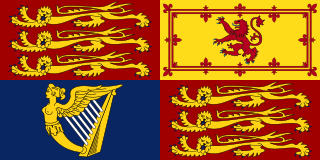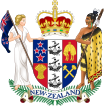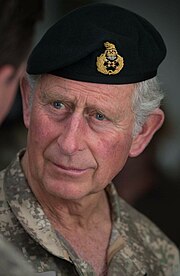The New Zealand Defence Force is the three-branched military of New Zealand. The NZDF is responsible for the protection of the national security of New Zealand and her realm, promoting its interests, safeguarding peace and security, as well as supporting peacekeeping and humanitarian missions. It consists of three services: the Royal New Zealand Navy (RNZN), the New Zealand Army and the Royal New Zealand Air Force (RNZAF), as well as tri-service components. As of June 2023, the NZDF has a strength of 14,996 employees, consisting of 8,669 regular force personnel, 3,260 reserve force personnel and 3,067 civilian members. It is supported by the New Zealand Ministry of Defence (MOD) and is commanded by the Chief of Defence Force (CDF).

Governor-general, or governor general, is the title of an office-holder. In the context of governors-general and former British colonies, governors-general are appointed as viceroy to represent the monarch of a personal union in any sovereign state over which the monarch does not normally reign in person. Governors-general have also previously been appointed in respect of major colonial states or other territories held by either a monarchy or republic, such as Japan in Korea and Taiwan and France in Indochina.

The Ross Dependency is a region of Antarctica defined by a sector originating at the South Pole, passing along longitudes 160° east to 150° west, and terminating at latitude 60° south. It is claimed by New Zealand, a claim mutually accepted only by Australia, the UK, France and Norway, countries that also have territorial claims in Antarctica. Under the 1961 Antarctic Treaty, of which all territorial claimants are signatories, including New Zealand, all claims are held in abeyance. Article IV states: "No acts or activities taking place while the present Treaty is in force shall constitute a basis for asserting, supporting or denying a claim to territorial sovereignty in Antarctica or create any rights of sovereignty in Antarctica".

A commander-in-chief or supreme commander is the person who exercises supreme command and control over an armed force or a military branch. As a technical term, it refers to military competencies that reside in a country's executive leadership, a head of state, head of government, or other designated government official.

The Executive Council of New Zealand is the full group of "responsible advisers" to the governor-general, who advise on state and constitutional affairs. All government ministers must be appointed as executive councillors before they are appointed as ministers; therefore all members of Cabinet are also executive councillors. The governor-general signs a warrant of appointment for each member of the Executive Council, and separate warrants for each ministerial portfolio.

The Dominion of New Zealand was the historical successor to the Colony of New Zealand. It was a constitutional monarchy with a high level of self-government within the British Empire.

The monarchy of New Zealand is the constitutional system of government in which a hereditary monarch is the sovereign and head of state of New Zealand. The current monarch, King Charles III, acceded to the throne following the death of his mother, Queen Elizabeth II, on 8 September 2022 in the United Kingdom. The King's elder son, William, Prince of Wales, is the heir apparent.

The governor of the Falkland Islands is the representative of the British Crown in the Falkland Islands, acting "in His Majesty's name and on His Majesty's behalf" as the islands' de facto head of state in the absence of the British monarch. The role and powers of the governor are set out in Chapter II of the Falkland Islands Constitution. The governor in office resides at Government House, which serves as the official residence.

The Realm of New Zealand is the area over which the monarch of New Zealand is head of state. The realm is not a federation but is a collection of states and territories united under its monarch. New Zealand is an independent and sovereign state that has one territorial claim in Antarctica, one dependent territory (Tokelau), and two associated states. The Realm of New Zealand encompasses the three autonomous jurisdictions of New Zealand, the Cook Islands, and Niue.

The commander-in-chief of the Canadian Armed Forces exercises supreme command and control over Canada's military, the Canadian Armed Forces. Constitutionally, command-in-chief is vested in the Canadian monarch, presently King Charles III. Since the Letters Patent, 1947, were signed by King George VI, the governor general of Canada—presently Mary Simon—executes most of the duties of the sovereign, including in his role as commander-in-chief. Consequently, the governor general also uses the title Commander-in-Chief of the Canadian Forces. By protocol, the title used within international contexts is Commander-in-Chief of Canada.

The governor-general of New Zealand is the representative of the monarch of New Zealand, currently King Charles III. As the King is concurrently the monarch of 14 other Commonwealth realms and lives in the United Kingdom, he, on the advice of his New Zealand prime minister, appoints a governor-general to carry out his constitutional and ceremonial duties within the Realm of New Zealand.

The Cook Islands are a constitutional monarchy within the Realm of New Zealand. Under the Cook Islands Constitution, the Sovereign in Right of New Zealand has been Head of State of the Cook Islands since 4 August 1965. The Sovereign is represented by the King's Representative; as such, the King is the de jure head of state, holding several powers that are his alone, while the King's Representative is sometimes referred to as the de facto head of state. The viceregal position is currently held by Tom Marsters.
The Department of the Prime Minister and Cabinet is the central public service department of New Zealand, charged with providing support and advice to the governor-general, the prime minister and members of the Cabinet of New Zealand. The department is also charged with centrally leading New Zealand's "national security planning, which includes civil defence." The department's overall area of responsibility is in helping to provide, at an administrative level, the "constitutional and institutional glue" within New Zealand's parliamentary democracy. The department along with the Public Service Commission, and the Treasury constitute the central agencies or public service departments leading the state sector of New Zealand.

The New Zealand Government is the central government through which political authority is exercised in New Zealand. As in most other parliamentary democracies, the term "Government" refers chiefly to the executive branch, and more specifically to the collective ministry directing the executive. Based on the principle of responsible government, it operates within the framework that "the [King] reigns, but the government rules, so long as it has the support of the House of Representatives". The Cabinet Manual describes the main laws, rules and conventions affecting the conduct and operation of the Government.

The monarchy of Belize is a system of government in which a hereditary monarch is the sovereign and head of state of Belize. The current Belizean monarch and head of state since 8 September 2022, is King Charles III. As sovereign, he is the personal embodiment of the Belizean Crown. Although the person of the sovereign is shared with 14 other independent countries within the Commonwealth of Nations, each country's monarchy is separate and legally distinct. As a result, the current monarch is officially titled Kingof Belize and, in this capacity, he and other members of the royal family undertake public and private functions as representatives of the Belizean state. However, the King is the only member of the royal family with any constitutional role.

The monarchy of the Bahamas is a system of government in which a hereditary monarch is the sovereign and head of state of the Commonwealth of The Bahamas. The current Bahamian monarch and head of state, since 8 September 2022, is King Charles III. As sovereign, he is the personal embodiment of the Bahamian Crown. Although the person of the sovereign is equally shared with 14 other independent countries within the Commonwealth of Nations, each country's monarchy is separate and legally distinct. As a result, the current monarch is officially titled King of the Bahamas and, in this capacity, he and other members of the royal family undertake public and private functions domestically and abroad as representatives of the Bahamian state. However, the King is the only member of the Royal Family with any constitutional role.

Head of the Armed Forces is the position of the sovereign of the United Kingdom as commander-in-chief of the British Armed Forces. Supreme military authority vests in the monarch and extends to the exercise of several personal prerogatives. However, routine administration of the military is delegated as a matter of law to the Defence Council of the United Kingdom, a body officially charged with the direction and command of the Armed Forces. As the Defence Council and its service boards are all a part of the Ministry of Defence, which itself is a ministerial department of the Government of the United Kingdom, the prime minister makes the key decisions on the use of the Armed Forces, while the secretary of state for defence assists the prime minister in the development of defence policy and administers the day-to-day military operations.
The Letters Patent, 1947, are letters patent signed by George VI, as King of Canada, on 8 September 1947 and came into effect on 1 October of the same year. These letters, replacing the previous letters patent issued in 1931, reconstituted the Office of the governor general of Canada under the terms of the Constitution Act, 1867, expanding the governor general's ability to exercise the royal prerogative, thereby allowing her or him to use most of the "powers and authorities" lawfully belonging to the sovereign and to carry out an increased number of the sovereign's duties in "exceptional circumstances".

The Defence Act 1990 is an Act of Parliament in New Zealand which establishes the New Zealand Defence Force (NZDF) and defines the respective roles of, and relationships between, the minister of defence, the chief of defence force and the secretary of defence.

The Letters Patent Constituting the Office of Governor-General of New Zealand is a royal decree and a part of the uncodified New Zealand constitution. Sometimes known as the Letters Patent 1983, the instrument has been amended twice since its original issue in 1983. The letters patent—essentially an open letter from Queen Elizabeth II that is a legal instrument—constitutes the office of governor-general as the monarch's representative in the Realm of New Zealand, vests executive authority in the governor-general, establishes the Executive Council to advise the governor-general, and makes provision for the exercise of the governor-general's powers should the office be vacant.












